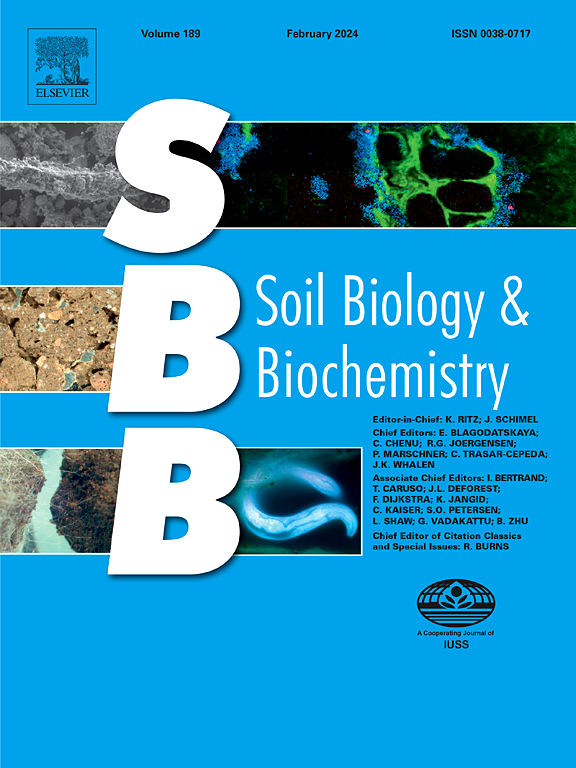Humidity controls soil organic carbon accrual in grassland on the Qinghai–Tibet Plateau
IF 9.8
1区 农林科学
Q1 SOIL SCIENCE
引用次数: 0
Abstract
The huge soil organic C (SOC) storage (around 34 Pg in the top 0.7 m) in Qinghai–Tibet Plateau (QTP) grasslands is commonly explained by slow decomposition of litter under cold climate therein, but this view may not be reliable as humidity also affects microbial activity. We sampled the 20 cm topsoil of grasslands along an altitudinal gradient from 1286 m on the western Loess Plateau (LP) to 4200 m above sea level on the northeastern QTP. The light-fraction SOC (LFOC), composition of non-cellulosic neutral carbohydrates, and amino sugars were used as biomarkers to investigate the intensity of microbial action on SOC as a function of climate along this altitudinal gradient. From the lowest-to the highest-humidity site with rising altitude, the root biomass tripled and the SOC content increased approximately sevenfold (from 13.5 g kg−1 to 93.3 g kg−1). The non-cellulosic neutral carbohydrate, microbial biomass C (MBC), and microbial necromass C (MNC) contents increased, but the LFOC content decreased. The contribution of MNC to the SOC and ratios between microbially- and plant-derived sugars in the non-cellulosic carbohydrate pool increased, but the proportion of LFOC in the SOC dropped. Consequently, besides the increased root biomass, the selective preservation of microbial compounds at colder and more humid sites contributed to SOC accruals in grasslands. The higher MBC in cold and humid grasslands perfectly explained the increased selective preservation of microbial derived C at the expense of plant C in higher-relative to lower-altitude areas. Importantly, the above humidity-controlled accumulations of microbial substances and SOC in grasslands were confirmed by results synthesized from published data across the LP and QTP. The higher SOC contents in cold and humid QTP grasslands relative to warm and dry regions were ascribed to the increased accumulation of microbial residues because of the increased humidity in QTP grasslands.
湿度控制青藏高原草地土壤有机碳的积累
青藏高原草地土壤有机碳(SOC)储量巨大(表层 0.7 米约 34 Pg),通常解释为寒冷气候条件下枯落物分解缓慢,但由于湿度也会影响微生物活动,这种观点可能并不可靠。我们沿黄土高原西部海拔 1286 米至青藏高原东北部海拔 4200 米的海拔梯度对草地 20 厘米表土进行了取样。以轻组分 SOC(LFOC)、非纤维素中性碳水化合物成分和氨基糖为生物标志物,研究微生物对 SOC 的作用强度与气候在这一海拔梯度上的函数关系。从湿度最低的地点到湿度最高的地点,随着海拔的升高,根部生物量增加了三倍,SOC 含量增加了约七倍(从 13.5 克/千克增加到 93.3 克/千克)。非纤维素中性碳水化合物、微生物生物量 C (MBC) 和微生物坏死物质 C (MNC) 含量增加,但 LFOC 含量减少。MNC 对 SOC 的贡献以及非纤维素碳水化合物池中微生物和植物衍生糖类的比例都有所增加,但 LFOC 在 SOC 中的比例却有所下降。因此,除了根部生物量增加外,微生物化合物在较冷和较潮湿地点的选择性保存也是草地SOC累积的原因之一。相对于低海拔地区,高海拔地区微生物产生的碳的选择性保存增加,而植物碳的选择性保存则减少。重要的是,根据低纬度地区和高纬度地区已发表的数据综合得出的结果证实了上述受湿度控制的微生物物质和SOC在草原上的积累。寒冷潮湿的 QTP 草原的 SOC 含量高于温暖干旱地区,这是因为 QTP 草原湿度增加,微生物残留物积累增加。
本文章由计算机程序翻译,如有差异,请以英文原文为准。
求助全文
约1分钟内获得全文
求助全文
来源期刊

Soil Biology & Biochemistry
农林科学-土壤科学
CiteScore
16.90
自引率
9.30%
发文量
312
审稿时长
49 days
期刊介绍:
Soil Biology & Biochemistry publishes original research articles of international significance focusing on biological processes in soil and their applications to soil and environmental quality. Major topics include the ecology and biochemical processes of soil organisms, their effects on the environment, and interactions with plants. The journal also welcomes state-of-the-art reviews and discussions on contemporary research in soil biology and biochemistry.
 求助内容:
求助内容: 应助结果提醒方式:
应助结果提醒方式:


